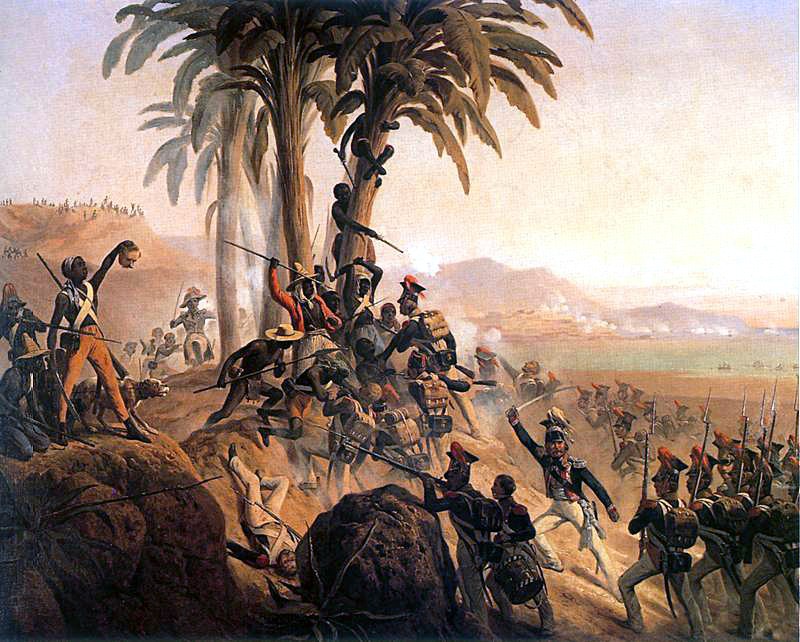4: A Revolutionary New World - 1600-1850
- Page ID
- 147160
- Analyze the Atlantic Revolutions and their impact on not only the countries where these revolutions occurred but also other colonized regions.
- Understand the role colonialism and rebellion played in changes to geopolitics and the world market.
- Define Absolutism and understand how this government structure was established as either a successful or unsuccessful authority over a population.
- What was unique about the Haitian Revolution?
- Why was the Age of Enlightenment an important event? Who ultimately benefited from the movement, and why?

Introduction
When talking about major concepts and events of the eighteenth and nineteenth centuries, the narrative often focuses on Europe, with these then radiating outward from that location. This is known as Eurocentrism, the idea that modern civilization, civility, and sophisticated society originated in Europe; this concept is described more thoroughly in Chapter 3 in the context of the Age of Exploration and Europe’s colonization of the American continents. However, as European colonies on the American continent grew and the United States formed and spread, this term changed to encompass the European foundation of these locations, and it became Westernization. Variations of this term, such as “Americanization,” have been introduced and applied. Americanization refers to attempts made by European colonists who later became US citizens to force American indigenous assimilation, often forcefully and violently, to European standards. The use of racial slurs and derogatory slang comes from these concepts as well, such as the idea that the heterosexual, cis-gendered, white male Protestant Anglo-Saxon European is the epitome of social and cultural superiority over any other society or culture. However, the stories of these historically marginalized populations provide a valid perspective as well, one that is now gaining more ground in historical studies. This chapter aims to share those stories from the voices of the past who weren’t allowed to be heard, or even actively silenced. The people of those societies who were deemed “savage” or “uncivilized” through Eurocentrism and Westernization had – and still have – rich cultures and traditions that contributed to the development of the world through trade in the world market and geopolitical alliances.
The Age of Exploration, introduced in the previous chapter, opened doors to new societies, cultures, and ways of thinking. This period of time came to be known as the Age of Enlightenment in Europe, where new ideas and concepts about religion and society grew. What was considered reason and rational thought based on the sciences gained popularity during this period. The British colonies on the American continents embraced these new concepts, especially John Locke’s ideas on “natural laws”, leading a handful of followers to rebel against the English government structure to form a new country.
During the seventeenth and early eighteenth centuries, another new ruling structure emerged, known as Absolutism, which basically allows unrestrained rulership with little to no oversight from any other entities, including the church, a council, nobles, scholars, or any other group or citizen. For those in control of these regions, their rule was ordained by God, so they answered only to God, and any resistance to this was met with quick and brutal restraint, up to and including exile and death. In Prussia, the emperor was known to cut the ears off of those who opposed his policies, and in France during the reign of Louis XIV, a courtier could find themselves unable to leave Versailles, a veritable prison, if a luxurious one, that was designed to force someone who displeased the king to live that displeasure every day of their life. The relative success of these territories’ rulers would inspire future leaders, particularly in the early twentieth century, covered in a later chapter.
The American Revolutionary War and its ideals trickled down to other places, including France, Haiti, Mexico, and other Atlantic countries and regions, giving rise to nationalism and with it, a new concept defining who the citizens of a region or territory were. Enlightenment-era philosophers mixed science and religion, leading to Deism, a belief that moves Christian religion outside of the mainstream. The backlash to this was The Great Awakening and the rise of new Christian sects in the fledgling United States that would spread throughout the world. The Enlightenment and French Revolutions provided the inspiration for a successful slave revolt in Haiti. Napoleon had recruited thousands of Polish soldiers to put down the revolt in Haiti. Figure 4.1 is a painting by a Polish artist named January Suchodolski, who painted many pictures with military themes. The painting shown in Figure 4.1 is titled "Battle of Palm Tree Hill," and it depicts a battle between Black Haitian rebels and Polish troops who fought on the side of the French colonizers. Armed Haitian rebels are seen marching up a hill atop which is a group of Palm trees. In the left corner of the picture a black soldier is holding the decapitated head of an European soldier. Some Polish soldiers later turned against the French colonizers and fought on the side of the Haitian rebels.
Much of the expansion taking place during this time came as a result of this new era of reason, which provided a justification for the colonizers to occupy a territory or region that was already occupied by indigenous populations. Europe was proving particularly adept at this, having embraced the belief that they alone encompassed all definitions of “civilized”, and they were delighted to share this belief with the rest of the world, attempting to raise the more savage or primitive regions to the European “level” of civility while exploiting the raw materials and labor that could be found in large amounts in these regions.
This expansion was also fueled by the growth of these Christian sects that espoused proselytizing and conversion, which was accompanied by a belief that Western civilization had a “God-given” right to move into these areas, if for nothing else but to save more heathen souls through hard work under the colonizers. Known as Manifest Destiny, a concept named in the mid-nineteenth century, this belief would justify the expansion of the United States from one end of the North American continent to the other, as well as the movement of Europeans into areas that could be used for economic and political gain.
Various means of colonizing areas were employed, whether financially, politically, religiously, or even by force. Most colonization, however, took place slowly and subtly. India was a prime example of this, with Britain entering through political and financial support on the surface while working to undermine production and trade behind the scenes, ultimately taking over all aspects of the country, including government, trade and economy, society, and culture. This was the point at which Britain also introduced the next era of globalization, the First Industrial Revolution.
- 4.1: Absolutist States
- The biggest change occurring with the rise of absolutism was economic in nature; it signaled an end to feudalism and the early stages of what would become a capitalist system, where money and trade goods – and the ability to acquire both – could potentially unseat a ruler or cause conflict within their realm. This section looks at the government structure of Absolutism that grew during the seventeenth and eighteenth centuries.
- 4.2: Age of Enlightenment in Europe
- The Age of Enlightenment encouraged a gradual shift from an understanding of political sovereignty as a gift of God to ideas of popular sovereignty and government by consent of the governed or through a “social contract” between rulers and people. This section explores the concept of Enlightenment and how it applied to a social, political, religious, and cultural movement taking place in Europe during the eighteenth century. While this section is more Eurocentric in nature, it sets the foundatio
- 4.3: Atlantic Revolutions
- This section focuses mostly on revolutions involving freed individuals against either a colonial ruling structure or an oppressive national government. It has been separated out from a revolution involving enslaved people rising up against their captors. While this has a Eurocentric perspective (definition in the key terms section), it still shows the effect of the Age of Enlightenment on European countries and colonies, and set the foundation for new government structures to develop.
- 4.4: Sugar and the Haitian Revolution
- The Haitian Revolution had a significant ripple effect on slavery and slave owners throughout North American and Caribbean colonies, mainly due to its successful conclusion with the end of slavery and renaming of the territory. This section examines the Haitian Revolution and its effect on slavery in North and Latin American colonies, territories, and nations.
- 4.5: Chapter Summary and Key Terms
- The revolutionary movements seen here were truly revolutionary in many ways; the idea that “ordinary” people could rise up and refuse to be subject to authoritarian power was a concept alien to many and had been for many years, as indicated by the absolutism government structure that dominated many major world powers.
- 4.6: Further Reading and Works Cited
- This section includes the resources used to remix this chapter as well as supplementary readings for continued study.
Thumbnail: Painting titled "Battle for Palm Tree Hill" highlighting the Haitian Revolution, January Suchodolski, in the Public Domain.


